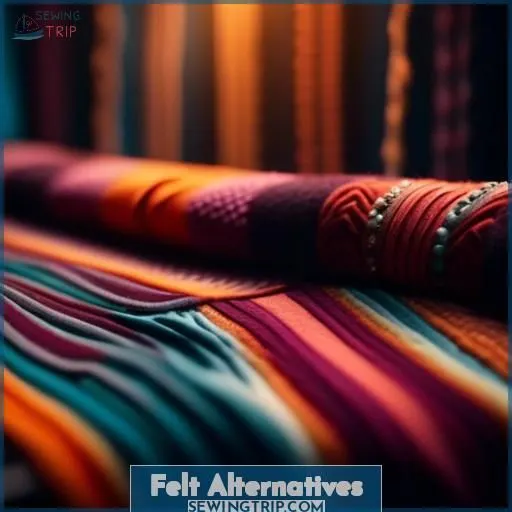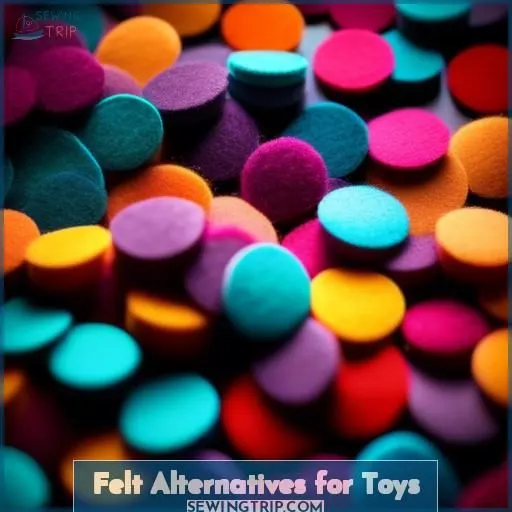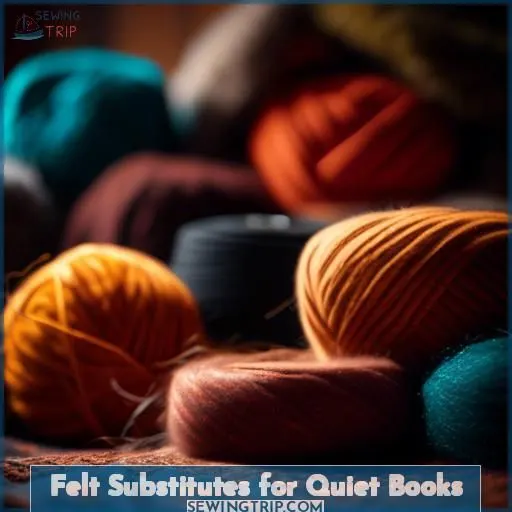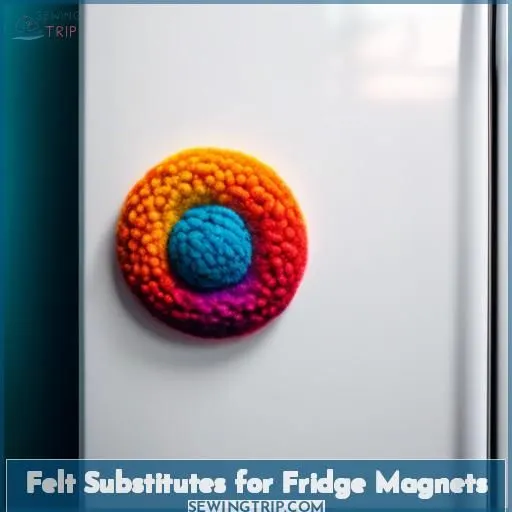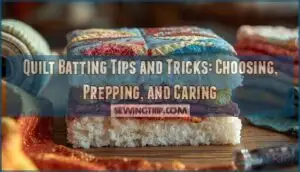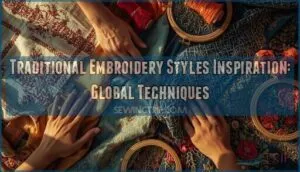This site is supported by our readers. We may earn a commission, at no cost to you, if you purchase through links.

Seeking eco-friendly, durable felt fabric substitutes?
Consider acrylic felt—affordable and versatile.
Faux suede offers a smooth, easy-to-clean texture.
Polar fleece is lightweight, warm, and quick-drying.
Cotton felt is plant-based and dyeable.
Hemp felt, derived from hemp fibers, provides an eco-conscious option.
Recycled plastic felt (Ecofelt) offers sustainability with a unique texture.
When selecting substitutes, factor in the intended use, washability, and desired thickness.
Explore their suitability for toys, quiet books, or fridge magnets—their applications reveal further insights.
Table Of Contents
Key Takeaways
- Felt fabric substitutes include acrylic felt, wool felt, faux suede, polar fleece, cotton felt, hemp felt, recycled plastic felt (Ecofelt), denim, and corduroy.
- Acrylic felt is durable, affordable, and versatile, making it suitable for various applications.
- Wool felt can shrink and thicken when washed, making it less suitable for eco-friendly, allergy-friendly, and washing-friendly alternatives.
- Faux suede offers a smooth texture, durability, and easy cleaning, while polar fleece is lightweight, warm, and quick-drying. Cotton felt is plant-based and dyeable, and hemp felt is derived from hemp fibers, providing an eco-conscious option. Recycled plastic felt (Ecofelt) offers sustainability with a unique texture.
Felt Alternatives
You have several options when it comes to felt fabric substitutes that are eco-friendly, durable, and affordable. Alternatives include acrylic felt, wool felt, faux suede, polar fleece, cotton felt, hemp felt, recycled plastic felt (Ecofelt), as well as other materials like denim or corduroy that can be repurposed into felt-like fabrics.
Acrylic Felt
Acrylic felt is a popular alternative to traditional felt due to its durability, affordability, and versatility. Here are three reasons why acrylic felt is a great choice for your sewing projects:
- Durability: Acrylic felt is resistant to pilling, ensuring your projects maintain their appearance even after multiple washes.
- Affordability: Compared to wool felt, acrylic felt is more cost-effective, making it a budget-friendly option for your sewing needs.
- Versatility: Acrylic felt can be used for various applications, including applique, and is suitable for creating eco-friendly toys, quiet books, and fridge magnets.
Wool Felt
Wool felt is a popular choice for various craft projects.
However, it has its drawbacks.
It can shrink and thicken when washed, which may affect the final product’s appearance.
Allergic individuals should also avoid wool due to its potential for triggering reactions.
Wool’s sustainability and sourcing are also questionable compared to other alternatives.
If you’re looking for an eco-friendly, allergy-friendly, and washing-friendly alternative, consider cotton or hemp felt.
These can be dyed to match your desired colors.
Faux Suede
Diving into the world of faux suede, you’ll find it’s not just a fabric, but a revolution in crafting. Here’s why:
- Texture: Its smoothness rivals real suede, perfect for that anime hair or chic short hairstyle in your next project.
- Durability: Tougher than it looks, it withstands creative mishaps.
- Cleaning: A breeze with cold water, keeping your creations fresh.
- Cost & Versatility: Surprisingly affordable, it’s a wig alternative superstar, bending to your crafting whims without breaking the bank.
Polar Fleece
Polar fleece is a great felt alternative for those seeking eco-friendly, durable, and affordable options. Here are four reasons why you should consider polar fleece for your next project:
- Benefits: Polar fleece is lightweight, warm, and quick-drying, making it perfect for a variety of applications[4.1].
- Uses: It’s commonly used for insulation, clothing, and upholstery[4.1].
- Care: Polar fleece can be machine washed in cold water, dried on low heat, or air dried, and ironed on low heat[4.4].
- Machine Washing and Hand Washing: For machine washing, use a gentle cycle and avoid high temperatures. For hand washing, use a mild detergent and rinse thoroughly[4.5].
Cotton Felt
Cotton felt is an eco-friendly alternative to traditional wool felt, offering a plant-based option for those seeking a more sustainable choice. Here are four key points about cotton felt:
- Dyeing: It can be dyed to various colors, allowing for a wide range of options.
- Thickness: While not as thick as wool felt, cotton felt can still provide a decent level of stiffness.
- Stiffness: The stiffness may vary depending on the quality of the cotton fibers used.
- Availability & Uses: Cotton felt is widely available and can be used for a variety of crafts, including toys, quiet books, and fridge magnets.
Hemp Felt
Hemp felt is a sustainable alternative to traditional felt.
It is made from the fibers of the hemp plant.
Hemp felt is eco-friendly and can be dyed in various colors, providing a wide range of options.
While it may not be as thick or stiff as wool felt, hemp felt is more durable and affordable.
It can be used for applique, toys, and other crafts.
Hemp felt offers a unique texture and look.
Recycled Plastic Felt (Ecofelt)
Ecofelt, a felt made from recycled plastic, is an eco-friendly alternative to traditional felt.
It’s made from post-consumer waste and has a unique texture.
However, it may not be as thick or stiff as wool felt, which could impact its suitability for certain projects.
Ecofelt is available in various colors and can be purchased online.
It’s washable but may not be as durable as other felt alternatives.
Despite these considerations, Ecofelt is a cost-effective and environmentally conscious choice for those looking to reduce their environmental impact.
Other Felt Substitutes
Expanding beyond Ecofelt, let’s explore the realm of alternative felt substitutes that prioritize eco-friendliness, innovation, and safety for your crafting endeavors:
- Hemp felt – a stalwart, plant-derived champion.
- Recycled felt – revitalizing old plastics into vibrant creations.
- Bamboo felt – velvety, sustainable, and surprisingly resilient.
- Rayon and nylon felt – synthetic yet adaptable, ideal for distinctive projects.
Felt Care
Felt fabric requires special care to maintain its durability and appearance. Here are some tips for cleaning, storing, and repairing felt:
Cleaning:
- Start by dabbing a small amount of gentle dish soap, such as Ivory or Dawn, directly onto the stain and blotting it with a soft, damp cloth.
- If the felt is dirty with dry debris, allow the spillage to dry before cleaning to prevent damaging the fibers.
- For stubborn stains, use a soft bristled brush to gently brush away any debris.
- If the felt is still damp after cleaning, allow it to air-dry in a cool place.
Storage:
- Store felt in a cool, dry place to prevent it from sticking together.
- Rolling the felt helps to avoid it getting creased or folded.
- If using a file organizing system, make sure it’s well-ventilated to prevent mold growth.
Ironing:
- Felt can be ironed on low heat, but avoid direct contact with the iron.
- Use a pressing cloth to protect the felt from the heat.
Dyeing:
- If you need to dye felt, use plant-based textile dyes and follow the manufacturer’s instructions.
Repairs:
- For small tears or holes, use a felt needle and thread to sew the damaged area.
- For larger repairs, consider using a patch of matching felt and sewing it onto the damaged area.
Felt Alternatives for Toys
If you’re looking for eco-friendly alternatives to felt for your toy-making projects, consider these four options:
- Cotton Felt: This plant-based material offers a similar texture and stiffness to traditional felt, making it a great substitute for your toy creations.
- Hemp Felt: Similar to cotton, hemp felt is another plant-based alternative that can be used for toys. It may have a slightly different texture and thickness, but it’s still a viable option.
- Polar Fleece: Known for its thickness and durability, polar fleece is a suitable alternative for toys. It may not have the same vibrant colors as acrylic felt, but it can still create a variety of toy designs.
- Faux Suede: This synthetic material is a great choice for applique work on toys. It doesn’t fray or stretch, and it can be washed in cold water and dried on low heat or air dried.
Felt Substitutes for Quiet Books
If you’re looking for a durable and washable alternative to felt for your quiet books, consider using cotton felt. This plant-based material offers a similar stiffness to acrylic felt and can be dyed to match a wide range of colors.
Hemp felt is another eco-friendly option, made from the fibers of the hemp plant.
Both cotton and hemp felt are more sustainable than traditional wool felt, which can shrink and thicken when washed.
For a more sustainable source, you might also consider recycled plastic felt, known as Ecofelt. However, keep in mind that Ecofelt may not be suitable for children’s toys due to its plastic composition.
When choosing a felt substitute for your quiet books, consider the material’s durability, washability, colorfastness, sourcing, and sustainability.
Felt Substitutes for Fridge Magnets
Regarding the creation of refrigerator magnets, felt is a widely used choice because of its adaptability and diverse color options. However, there are alternative materials that provide comparable durability and ease of maintenance. Here are three possibilities to investigate:
- Artificial Suede: For appliqué work, this material is a suitable substitute for felt. It resists fraying and stretching, and with faux suede, adhesive webbing mightn’t be required.
- Polyester Fleece: This material is thicker than faux suede and performs well in appliqué projects. It’s also simple to clean and can be employed for refrigerator magnets.
- Organic Felt: Although not as prevalent as acrylic or wool felt, organic felt is an environmentally friendly option. It’s derived from plant-based materials and can be dyed to match a wide range of hues.
When determining the size and configuration of your refrigerator magnets, the following factors should be considered:
- Magnet Dimensions: The size of the magnet should correspond to the quantity of information and visual components you wish to incorporate. For refrigerator magnets, a size of roughly 1.5 by 2.7 is recommended, as it allows your design to stand out without consuming excessive space.
- Magnet Configuration: Magnets are available in a variety of configurations, including bars, rings, discs, horseshoes, cubes, and rectangles. The shape you select will be contingent on the intended use.
- Magnet Intensity: The appropriate magnet strength will be determined by the intended use. For refrigerator magnets, a strength of approximately 200-300 Gauss is typically adequate.
- Magnet Composition: Neodymium magnets represent the most potent material available, while ferrite magnets are more cost-effective. Samarium cobalt magnets exhibit superior temperature resistance, while alnico magnets also possess considerable strength.
Frequently Asked Questions (FAQs)
What are the best materials for making eco-friendly felt substitutes for toys?
Hey there! For eco-friendly felt alternatives, you can’t go wrong with wool, cotton, or hemp felt. They’re sustainable, allergy-friendly, and come in tons of vibrant colors – perfect for kid-safe toy making!
How does the dyeing process differ between wool and hemp fibers when used to make felt?
Like a vibrant sunrise, dyeing hemp and wool fibers produces contrasting hues. While wool embraces dye easily, hemp’s porous nature demands extra coaxing for deep, saturated colors – a delicate dance mastered through patient technique.
What are the ideal washing instructions for faux suede used in applique projects?
You’ll want to carefully wash faux suede in cold water and tumble dry on low heat or air dry. It can handle low iron temps too. Treat it gently – this synthetic textile is durable but can degrade if mishandled. With proper care, your appliques will last ages!
How does the thickness and density of various felt alternatives, such as wool blend felt and craft felt, compare?
Imagine a dense forest – the wool felt is a thicket of interwoven branches, craft felt like sparse underbrush. Wool’s tight weave yields resilient stability, while craft’s lightweight openness allows easy manipulation. Explore tactile richness by layering these contrasting textures into your tactile tapestry.
What are the most suitable methods for creating felted fabric from natural and synthetic fibers?
You can create felt by agitating and compressing fibers like wool or alpaca fur. For synthetics, you’ll need to needle-punch fibers into a dense mat. Get creative – try embellishing with silk sari remnants or adding aromatics like lavender for a personal touch!
Conclusion
Over 60% of households seek felt fabric substitutes for environmentally conscious projects.
You’ve explored versatile, durable alternatives like acrylic felt, faux suede, polar fleece, cotton felt, hemp felt, and recycled plastic felt.
Their unique properties cater to diverse applications, from toys and quiet books to fridge magnets.
Carefully evaluate factors like intended use, washability, and desired thickness when selecting the most suitable felt fabric substitute.

